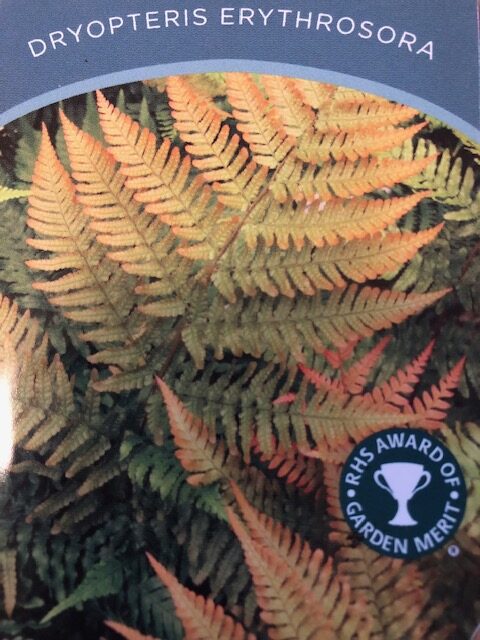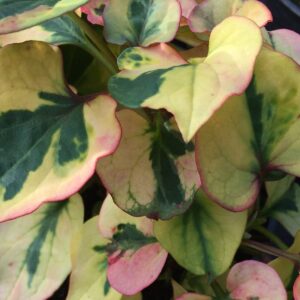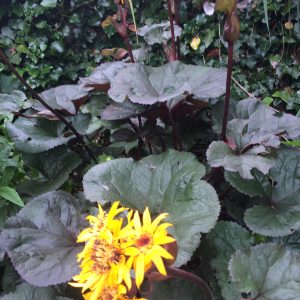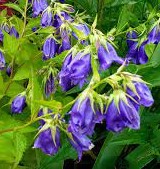Dryopteris erythrosora
Autumn Fern
One cannot help but be drawn in by the striking appearance of Dryopteris erythrosora. This deciduous fern is known for its elegant fronds, which unfurl in a symphony of color throughout the growing season. Early in the spring, the fronds emerge in shades of coppery-red, hence the common name “Autumn Fern.” As the season progresses, these fronds transition to a lustrous dark green, creating a dynamic display of color in the garden, growing to a height and spread of 60cm.
This fern is equally versatile when it comes to soil types. It prefers well-drained, humus-rich soils but can tolerate a variety of soil conditions, from loamy to clayey. However, ensuring adequate moisture levels is essential for its optimal growth. Shady or partially shaded areas are the preferred locations for ,Dryopteris erythrosora as it naturally thrives beneath the canopy of trees in its native habitat.
The fronds themselves are pinnate, with each leaflet delicately arranged along the stem. The fine texture of the fronds adds a touch of sophistication to any garden landscape. In the autumn, Dryopteris erythrosora lives up to its name as the foliage transforms into a beautiful blend of autumnal hues, making it a standout feature in the fall garden.
One of the remarkable qualities of Dryopteris erythrosora is its adaptability to a wide range of growing conditions. Native to East Asia, it thrives in both temperate and subtropical regions, making it an ideal choice for gardens across the world. Whether you reside in a region with cold winters or mild year-round temperatures, the Autumn Fern can find a place in your garden.
Understanding the life cycle of can deepen one’s Dryopteris erythrosora appreciation for this garden gem. Like all ferns, it undergoes a fascinating process of reproduction known as alternation of generations. The familiar fronds we see are part of the sporophyte generation, which produces spores in structures called sori on the undersides of the fronds. These spores are released into the environment and, if conditions are favorable, develop into gametophytes.
The gametophytes are small, heart-shaped structures that are usually green and grow close to the ground. They produce male and female reproductive structures, and when fertilization occurs, a new sporophyte generation begins to grow, eventually developing into the recognizable fronds. This intricate life cycle is a testament to the resilience and adaptability of ferns like Dryopteris erythrosora.
When it comes to propagating Dryopteris erythrosora in your garden, you can use both spores and rhizomes. Spores are collected from mature fronds, sown on a suitable substrate, and nurtured until they develop into gametophytes. Once gametophytes are established, they can be transplanted into the garden to grow into mature ferns.
Alternatively, you can divide established clumps of by Dryopteris erythrosora by separating the rhizomes, ensuring that each division has both roots and fronds. This method is faster and often more reliable, making it a preferred choice for gardeners looking to expand their Autumn Fern collection.
Caring for Dryopteris erythrosora is relatively straightforward, making it an excellent choice for gardeners of all skill levels. As previously mentioned, this fern prefers partial to full shade, making it an ideal companion for other shade-loving plants such as hostas and astilbes. Adequate moisture is essential, so be sure to water consistently, especially during dry spells.
Mulching around the base of the fern can help retain moisture and regulate soil temperature. In colder climates, adding a layer of mulch in late fall can also provide some winter protection. While Dryopteris erythrosora is relatively pest and disease-resistant, it’s essential to monitor for signs of infestations or issues such as dry or damaged fronds and address them promptly.
Dryopteris erythrosora, the Autumn Fern, is a captivating addition to any garden, offering year-round interest and adaptability to various growing conditions. Its striking foliage, intriguing life cycle, and ease of care make it a beloved choice among gardeners. Whether you are a seasoned horticulturist or a beginner with a green thumb, consider adding the enchanting Dryopteris erythrosa to your garden for a touch of timeless elegance and natural beauty.






Reviews
There are no reviews yet.